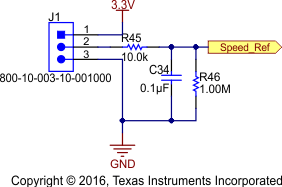TIDUCL0 January 2017
- 1 Description
- 2 Resources
- 3 Features
- 4 Applications
- 5 Design Images
- 6 System Overview
-
7 System Design Theory
- 7.1 Power Stage Design—Battery Power Input to the Board
- 7.2 Power Stage Design—Three-Phase Inverter
- 7.3 Power Stage Design—DRV8323 Gate Driver
- 7.4 Power Stage Design—18-V to 3.3-V DC-DC Converter
- 7.5 Power Stage Design —Microcontroller MSP430
- 7.6 Power Stage Design—Hall Sensor Interface
- 7.7 Temperature Sensing
- 7.8 Power Stage Design—External Interface Options and Indications
- 8 Getting Started Hardware and Software
- 9 Testing and Results
- 10Design Files
- 11Software Files
- 12Related Documentation
- 13Terminology
- 14About the Author
7.8.1 Speed Control of Motor
The speed control is done using a potentiometer (POT), and the POT voltage is fed to the ADC of the MCU. The circuit is shown in Figure 11. The POT is supplied from the 3.3 V. A 20k POT can be connected externally to the jumper J1. Connect the fixed terminals of the POT to terminal 1 and 3 of J1 and mid-point to terminal 2 of J1.
 Figure 11. Potentiometer Connection for Speed Control Schematic
Figure 11. Potentiometer Connection for Speed Control Schematic The resistor R46 is used to ensure that the speed control reference is zero if the POT terminal is open.